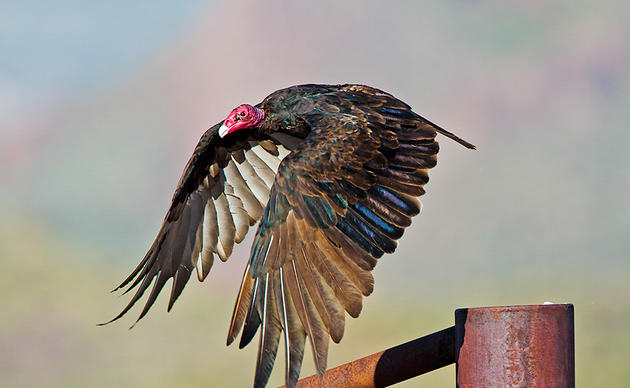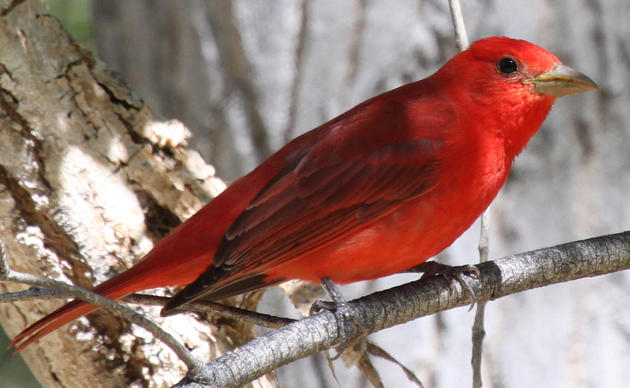Kern River Valley Invasive Species Information
Staff and volunteers of the Kern River Preserve have spent over a decade fighting invasive species. These efforts have paid off with one of the most native forests in western North America.
Each year staff of the Kern River Preserve, volunteers, and the California Department of Fish & Game spent time eradicating purple loosestrife and perennial pepperweed from Sprague Ranch and nearby South Fork lands.
Each of us can help prevent the spread of invasive plants and animals. You can help by learning which species can become invasive and eradicate these from your own yards. Help to educate your local nurseries about the problem with invasives and get them to stop selling problem plants. Contact your legislator and local agriculture commissioner to make sure no invasives are sold or promoted in your county or town.
The following list contains invasive plants that can threaten ecosystems of the Kern River Valley.
tree-of-heaven - Ailanthus altissima
giant cane - Arundo donax
Australian saltbush - Atriplex semibaccata
bassia - Bassia hyssopifolia
Sahara mustard - Brassica tournefortii
red brome - Bromus madritensis ssp. rubens
cheatgrass - Bromus tectorum
lens-podded hoary cress - Cardaria chalepensis
white top - Cardaria draba
Italian thistle - Carduus pycnocephalus
tocolote - Centaurea melitensis
yellow starthistle - Centaurea solstitialis
Canada thistle - Cirsium arvense
bull thistle - Cirsium vulgare
poison hemlock - Conium maculatum
artichoke thistle - Cynara cardunculus
Scotch broom - Cytisus scoparius
water hyacinth - Eichhornia crassipes
Russian olive - Elaeagnus angustifolia
edible fig - Ficus carica
fennel - Foeniculum vulgare
French broom - Genista monspessulana
perennial pepperweed - Lepidium latifolium
purple loosestrife - Lythrum salicaria
fountain grass- Pennisetum setaceum
Harding grass - Phalaris aquatica
castor bean - Ricinus communis
black locust - Robinia pseudoacacia
Himalayan blackberry - Rubus discolor
Mediterranean grass - Schismus arabicus
Spanish broom - Spartium junceum
medusahead - Taeniatherum caput-medusae
smallflower tamarisk - Tamarix parviflora
saltcedar - Tamarix ramosissima
wooly mullein - Verbascum thapsus
periwinkle -Vinca major
Invasive Animals
Fish
goldfish - Carassius auratus
common carp - Cyprinus carpio
brown trout - Salmo trutta
brook trout - Salvelinus fontinalis
white bass - Morone chrysops
Amphibians
American Bullfrog - Rana catesbeiana
Tiger Salamander - Ambystoma tigrinum
Reptiles
Red-eared Slider - Trachemys scripta elegans
Yellowbelly Slider - Trachemys scripta scripta
Texas Tortoise - Gopherus berlandieri
Birds
Rock Pigeon - Columba livia
Eurasian Collared-Dove - Streptopelia decaocto
European Starling - Sturnus vulgaris
House Sparrow - Passer domesticus
Mammals
Red fox - Vulpes vulpes
Feral dog - Canis familiaris
Feral cat - Felis catus
Wild pig - Sus scrofa
Domestic goat - Ovis aries
Fox squirrel - Sciurus niger
Black rat - Rattus rattus*
House mouse - Mus musculus
European rabbit - Oryctolagus cuniculus
How you can help, right now
Visit us on Facebook
Keep up to date on everything happening at the Kern River Preserve and share highlight from your own visit.
Sign-up for Updates
Subscribe to our email list to know about upcoming festivals, volunteer days, and other events.
Make a Gift
Through the support of people like you, we can keep building a culture of conservation by working to protect wildlife habitat, cultural resources, and the diversity of life.


